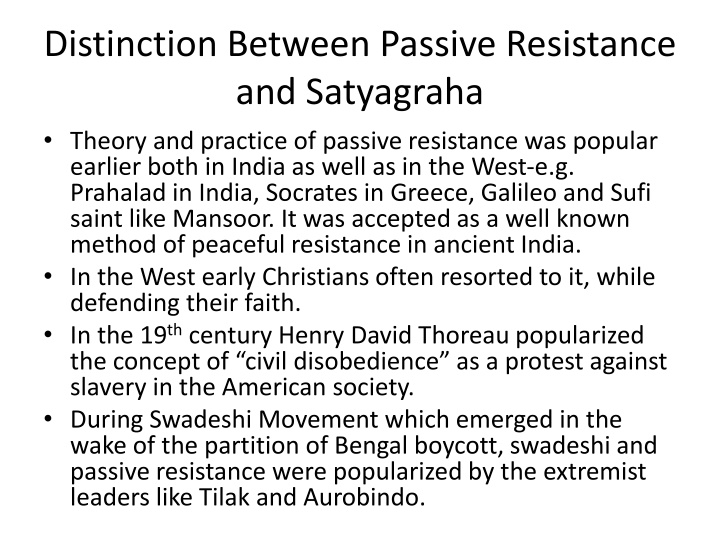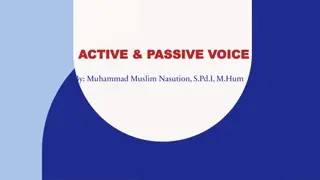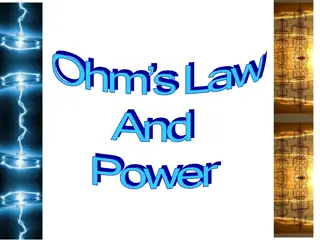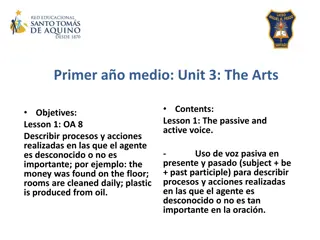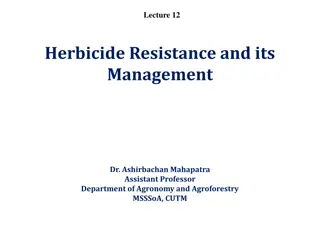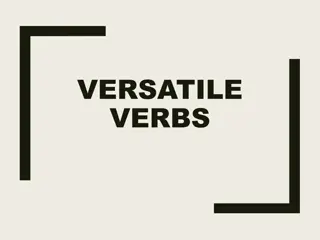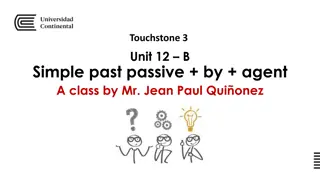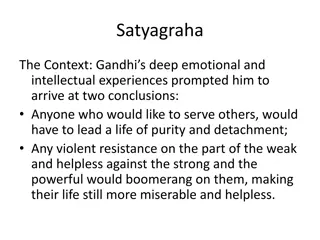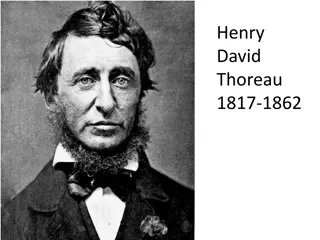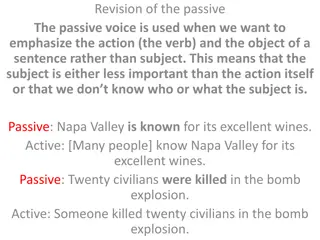Comparison between Passive Resistance and Satyagraha Theories
Passive resistance was used historically by figures like Gandhi, Thoreau, and early Christians for peaceful resistance. Satyagraha, introduced by Gandhi, differs by being a weapon of the strong focusing on love, self-realization, and unity rather than opposition and physical force. It emphasizes spiritual and moral upliftment for individuals and society.
Download Presentation

Please find below an Image/Link to download the presentation.
The content on the website is provided AS IS for your information and personal use only. It may not be sold, licensed, or shared on other websites without obtaining consent from the author.If you encounter any issues during the download, it is possible that the publisher has removed the file from their server.
You are allowed to download the files provided on this website for personal or commercial use, subject to the condition that they are used lawfully. All files are the property of their respective owners.
The content on the website is provided AS IS for your information and personal use only. It may not be sold, licensed, or shared on other websites without obtaining consent from the author.
E N D
Presentation Transcript
Distinction Between Passive Resistance and Satyagraha Theory and practice of passive resistance was popular earlier both in India as well as in the West-e.g. Prahalad in India, Socrates in Greece, Galileo and Sufi saint like Mansoor. It was accepted as a well known method of peaceful resistance in ancient India. In the West early Christians often resorted to it, while defending their faith. In the 19thcentury Henry David Thoreau popularized the concept of civil disobedience as a protest against slavery in the American society. During Swadeshi Movement which emerged in the wake of the partition of Bengal boycott, swadeshi and passive resistance were popularized by the extremist leaders like Tilak and Aurobindo.
Gandhi and Passive Resistance Initially, Gandhi himself used passive resistance to describe his fight against the racial discrimination in South Africa. Subsequently, Gandhi gave up the term passive resistance and consistently used the term satyagraha to describe his movement. Gandhi himself differentiated satyagraha from passive resistance on a number of counts:
Distinction Between Passive Resistance and Satyagraha One, passive resistance was taken as a weapon of the weak. One might give it up in the face of a stiff opposition. But satyagraha is designed as the weapon of the strong which purifies as well as strengthens the will and determination of the satyagrahi. A forced retreat is virtually ruled out in the case of satyagraha. Two, passive resistance is not based on the idea of love in the larger and deeper sense. Hence, it does not aim at self-realisation through the process of self- transformation. Satyagraha, on the contrary, is based on love in the larger and deeper sense which encompasses everything and everybody under its wings. In this struggle the other party is not taken as an enemy, rather, s/he is considered as a co-partner in the search for truth.
Distinction----(contd.) Three, the ideological basis of passive resistance is such that it does not exclude the use of physical force in all eventualities. Since it is the weapon of the weak, it symbolises a tactical line of action rather than a principled one. Satyagraha, on the other hand, is based on a clear understanding and a firm commitment to rule out the use of physical force in every eventuality. Four, passive resistance is based on the concept of the other, whereas satyagraha is based on the concept of brotherhood. There is no other for a satyagrahi-advaitic vision of the unity of all beings. Five, in passive resistance, physical injury to the other is not totally ruled out. In satyagraha, all sufferings including the physical one is directed against oneself. So the idea behind satyagraha is to resist the evil not with evil but with good. Thus, through satyagraha, an individual contributes not only to his own spiritual and moral uplift but also that of others. Both individuals and the society move on a higher plane in the process.
Bhikhu Parekhs Interpretation of Satyagraha According to Parekh Gandhi used the term satyagraha as it is understood in Gujarati and not strictly in the sense it is used in sanskrit. Satyagraha carries the meaning of insistence on truth without becoming obstinate or uncompromising on it (Gujarati sense). Gandhi s satyagraha is a necessary outcome of his theory of truth and nonviolence. Such a process requires a cooperative participation of the other party. Thus, according to Parekh, Gandhi s satyagraha is both epistemological as well as political; epistemological as it is an attempt at search for truth, and political because it ultimately leads to political action.
Parekh on Gandhian Methods of Conflict Resolution Parekh examines the question why Gandhi rejected both the prevailing methods of conflict resolution- rational discussion and violent confrontation. Gandhi found them lacking both on theoretical and practical levels. Rational discussion is rejected on the ground that it might go on endlessly without reaching a conclusive end as one of the parties might be determined not to be convinced by the other. Besides, Gandhi was convinced that appealing to rationality is not enough; one s heart and soul has to be touched to enable him/her to see the truth in the opponent s vision.
On Rejection of Violence Violence was rejected by Gandhi on a number of counts: One, since no one has absolute truth s/he has no right to impose his/her views on the other, least of all in a violent way. ii. Two, imposition of one s views on other in a violent way would only ensure the recurrence of persistent violence. iii. Three, no noble ends could be achieved by ignoble means. i.
Satyagraha as the most Appropriate Method of Conflict Resolution Gandhi opts and pleads for satyagraha as the most appropriate method of conflict resolution on the following grounds: i. First, it takes both head and heart- both rational and emotional elements to see the righteousness of another s viewpoint. ii. Satyagraha goes beyond rational dialogue to touch the heart and soul of the other person by appealing to his/her deep sense of morality and humanity.
Gandhis Departure from Kant and John Rawls Parekh makes a valid point that Gandhi made a departure from Kant and John Rawls on the issue of justice. Unlike them, Gandhi insisted on an emotionally charged sense of shared humanity. Gandhi was a practical visionary. So, he was aware that only a handful of satyagrahis could reach such moral and spiritual high level. That is why he evolved and used other forms of struggle, such as boycott, non-payment of taxes, long march like Dandi March, etc. which did not necessarily call for such moral and spiritual height. Parekh calls it the triumph of Gandhi s political realism over his moral idealism. Prekh is not enamored of Gandhi s introduction of fasting as a part of satyagraha. Even Gandhi was aware of its fragile nature and favoured it only in the extreme cases. Gandhi attached a number of qualifications on fasting being resorted to. He insisted that it was not a part of blackmail
Parekh on Limits of Satyagraha Parekh accepts that Gandhi s satyagraha made a major and creative contribution to the theory of social change and political action. Nonetheless Parekh finds some limits as well: First, Parekh rejects Gandhi s assertion that satyagraha would turn out to be the ultimate panacea for all human ills. There might be occasions when there could be genuine difference of opinion about the nature of human wellbeing- e.g. in cases like abortion, euthanasia and war on which even moral position could genuinely differ. Parekh finds it difficult to accept that such conflicts of opinion could be resolved through satyagraha. Secondly, there might be an occasion when suffering love of a satyagrahi might be viewed by the opposite party as a moral punishment s/he deserves
Parekh on Limits---(contd.) Another strong point made by Parekh is that violence need not be necessarily accompanied by ill will and evil designs. There might be occasions when violence might have moral roots and justifications. Parekh argues that Martin Luther King s Satyagraha in the American Civil Right Movement might not have passed all qualifications laid down by Gandhi. King was not so insistent on purity of means as the latter had insisted.
